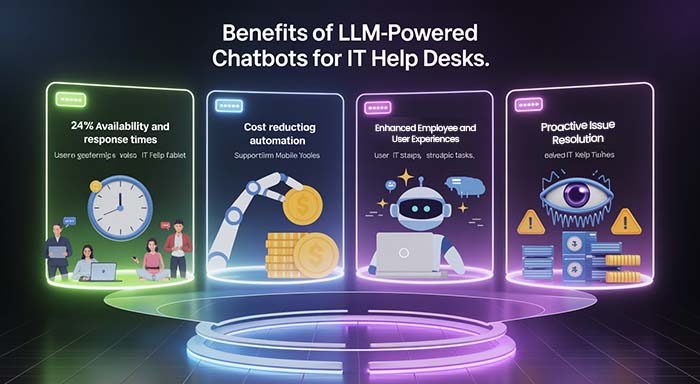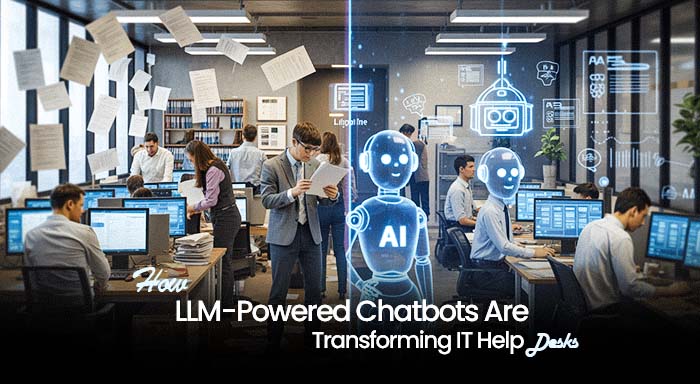Slow IT help desks can be frustrating. Long waiting times, incomplete answers, and repetitive issues are exhausting for both time and patience. It is essential for businesses to offer faster solutions for their teams without losing efficiency or quality. Let us introduce you to AI-powered chatbots. These advanced tools have changed how IT support operates. They can answer questions faster, lowering costs, and solving problems before they grow. In this blog, we have discussed how these chatbots can improve the IT help desks while addressing concerns you might have about them.
Key Features of LLM-Powered Chatbots
These chatbots interact with the users in a way that might seem natural and relatable. They gain insights from each interaction and adjust immediately to address future inquiries more effectively.
Natural Language Processing (NLP)
Natural Language Processing (NLP) helps chatbots to understand human languages. It can analyse complex sentences, identify context, and interpret user intent. Utilizing this, IT help desks can handle diverse queries with improved accuracy. For example, NLP can be used to distinguish between two different requests namely, a request for password reset and a report of server downtime without confusion.
NLP supports multiple languages which makes assistance accessible globally for businesses with international clients. Over-time, machine-based algorithms of these chatbots, amplify understanding by learning from past interactions. It can interpret slangs, abbreviations, or technical jargon effectively, saving time for your team who experience less frustration. With NLP, chatbots don't just respond, they comprehend. Machine Learning enhances this capability by teaching the bot to adapt after each new interaction.
Machine Learning and Adaptive Algorithms
Machine learning enables chatbots to analyse extensive data and improve responses over time. These algorithms study user interactions to identify patterns and adapt to the new information without any need for manual updates.
For instance, if a similar IT issue is reported by multiple users, the chatbot would learn to recognize it faster. It can then offer automated solutions more effectively.
Adaptive algorithms make chatbots smarter. They can learn to anticipate user needs based on past behaviour. The algorithms help improve response accuracy and prioritize relevant answers. LLM-powered and managed IT services benefit as repetitive tasks are reduced for the support teams while boosting overall efficiency. New Jersey's top IT consultants often utilize this adaptive tech to deploy AI solutions that can evolve with organizational demands. Further, integrating these chatbots with ITSM platforms, links this intelligence directly with the workflows to ensure smooth operations across help desks.
Integrating with ITSM Platforms
Integrating LLM-powered chatbots with ITSM platforms will streamline workflows. These chatbots can automatically record tickets, allocate tasks, and refresh statuses eliminating manual effort. This decreases mistakes and saves time for support teams. These connections also retrieve data from knowledge bases to deliver precise answers quickly. Chatbots work with tools like ServiceNow or JIRA, making them a perfect match for busy service desks. Businesses that implement comprehensive Houston IT support services often integrate these chatbots directly into their ITSM systems for maximum efficiency.
Benefits of LLM-Powered Chatbots for IT Help Desks

Common IT issues are addressed quickly and accurately which saves time for support teams. LLM-Powered chatbots have the capacity to learn and adjust which makes problem-solving efficient for everyone involved.
Companies like Element Logic US are leveraging AI innovations to streamline operations and improve customer interactions. Their tech-forward approach complements advancements like LLM-powered chatbots in driving smarter automation.
24/7 Accessibility and Reduced Response Times
LLM-powered chatbots never rest. Unlike traditional IT support teams, these AI-driven assistants stay active 24/7. You can reduce downtime by addressing incidents immediately, even during the weekends or holidays. Users no longer need to wait for regular office hours to get access to help.
This technology improves response time dramatically. Chatbots can process queries within seconds and provide solutions faster than human agents. For industries relying on tight schedules or having global operations, speed will keep the workflows running effortlessly without unnecessary interruptions. Cost savings through automation is an added significant benefit.
Automation to Reduce Costs
Handling repetitive IT help desk tasks manually can be expensive and time-consuming. AI-powered automation will remove this burden on the resources. Chatbots can manage ticket routing, password resets, and basic troubleshooting with no human intervention. This reduces the need for personnel while maintaining consistent performance.
For managed IT services, replacing manual processes with automated workflows will significantly reduce expenses annually. For instance, rather than employing multiple agents overnight, you can use chatbots to deliver continuous support to the users at a reduced cost. You can reallocate the funds toward growth initiatives.
Enhanced Employee and User Experiences
LLM-powered chatbots simplify IT support tasks. Employees receive immediate assistance with password resets, app errors, or access issues without enduring lengthy wait times. Prompt solutions ease frustration and enable teams to concentrate on their work.
These AI tools adapt and improve from interactions. They deliver increasingly precise responses over time, enhancing user experiences. Content employees are more productive, while users value quicker problem resolutions. Addressing issues in advance enhances this even further.
Proactive Issue Resolution
Chatbots foresee IT issues before they grow into larger problems. Machine learning algorithms can examine patterns to identify irregularities in advance and help avoid system downtimes or service interruptions. They notify the teams about potential risks or necessary repairs. Automated recommendations can assist technicians to detect and address root causes more adequately. This will ensure smoother operations and a reduction in recurring issues for improved results across the IT help desk environment.
Case Studies: Applications of LLM Chatbots in IT Help Desks in the Real World
Intricate support tickets can be managed by LLM chatbots with better accuracy. They can also decrease the workload of the support teams by automating routine tasks.
Use Cases
Today, many businesses have already implemented AI-powered IT help desk solutions and are benefitting from it. The practical uses showcase how organizations can achieve efficiency and better customer support.
- AI chatbots were introduced by Microsoft to assist employees with their IT concerns. The bots resolved 30% of the repetitive issues with no human help and accelerated support services.
- IBM implemented language models that can guide users through their system setup and troubleshooting. With this, they decreased the downtime for their team by more than 20%.
- A leading healthcare provider employed conversational interfaces that can automatically schedule IT maintenance tasks. This reduced service delays in critical environments.
- Google adopted virtual assistants to manage hardware requests. They were able to cut down response time by half and internal employee satisfaction scores saw significant improvement.
- A multinational bank applied automated customer support tools for password resets and basic security guidance, lowering call center volume by 40%.
These examples showcase only a portion of the opportunities LLM chatbots offer businesses today—examining challenges and obstacles they introduce next!
Testimonials
Businesses across the globe are witnessing firsthand how LLM-powered chatbots have enhanced their IT support. Their impact on customer experience and efficiency is highlighted by the practical implementation.
- Introduction of an AI-powered virtual assistant in a global software company reduced response times by 50% and over 60% of incoming IT queries were addressed by the tool without human help.
- Automation was implemented by an international retail brand to assist with basic troubleshooting for employees across multiple offices. Their IT help desk witnessed cost reduction by 30% within six months.
- A leading healthcare provider adopted conversational interfaces to manage password reset requests. 80% of these issues were resolved in under a minute, freeing up staff for essential tasks.
- One major telecommunications firm increased employee satisfaction ratings by 40%. Their chatbot provided accurate resolutions and eliminated long wait times.
- A mid-sized manufacturing company incorporated language model algorithms into its internal IT systems, reducing downtime during production halts by quickly diagnosing server errors.
- To assist students with their tech-related issues during online learning sessions, an educational institution introduced chatbots. They recorded an all-time low escalation rate of just 15%.
- A managed service provider adopted automated customer support solutions powered by machine learning tools. They reported a tenfold increase in daily support ticket resolution speed.
- For a financial services leader, implementing natural language processing capabilities ensured clearer communication with non-technical users while reducing confusion in inquiries.
- During peak holiday hiring seasons, a logistics firm used AI-powered tools to onboard new employees faster by answering setup questions instantly and accurately.
- A government agency adopted generative AI for its multi-departmental help desk services and saw a 25% drop in unresolved tickets within the first quarter of implementation.
Challenges and Limitations of LLM Chatbots
Occasionally, while addressing intricate issues, LLM chatbots can fall short. They sometimes struggle with delicate language subtleties, requiring human intervention.
Incidental Need for Human Intervention
Complex technical issues demand human involvement. For example, occurrence of a server crash or an unexpected system outage warrants the involvement of IT staff. While chatbots excel at basic troubleshooting and can guide users through common problems, they cannot address very specific or unusual cases that require expertise and logical reasoning.
Emotional situations demand human support. Frustrated employees facing repeated disruptions seek someone that can empathise with them genuinely. Chatbots can deliver fastidious response, but they cannot match the understanding displayed by a live technician who has been trained to handle sensitive interactions.
Probable Biasness and Accuracy Issues
Biasness in AI chatbots can produce unfair outcomes. For IT help desks, this could lead to incorrect prioritization of tasks or unsuitable responses to user queries. It is pertinent for businesses to train their language models with diverse and representative data sets to avoid such risks. Regular audits of chatbot behaviour will help identify bias early, avoiding potential damage.
Accuracy issues stem from incomplete training or ambiguous inputs. Chatbots may deliver inaccurate solutions if they misinterpret user intent. Establishing feedback loops allows the system to learn from mistakes and improve its answers over time. Human oversight at critical points ensures customer support remains dependable and effective.
Predictions for LLM-Powered IT Help Desks
AI-driven chatbots have become smarter, more conversational, and better at predicting user needs. These advancements aim to revolutionize how IT teams tackle support challenges.
Evolution of AI and Generative Models
Generative AI is transforming IT support operations. Now these models can generate responses resembling human-like interactions, that has made interactions more effective and relatable. Advanced algorithms can learn from extensive amounts of data, equipping chatbots with the means to address complex queries with minimal mistakes.
These developments have provided IT help desks with significant advantages. Anticipatory features can empower systems to identify needs or detect recurring issues before they escalate. This has not only enhanced customer service but also minimized the downtime for businesses that depend on seamless IT operations.
Enhanced Personalization and Predictive Capabilities
Developments in AI have transformed customer support through smarter responses and quick problem-solving abilities. Chatbots can now analyse user interactions to anticipate their needs in advance. These systems take past behaviour, preferences, and similar issues into consideration using which IT service desks can address potential problems early and reduce the downtime for businesses.
Machine learning models learn from every interaction and constantly evolve. Thus, they can adjust to user patterns without waiting for manual updates. For example, a chatbot might recommend resetting a password after frequent login failures or schedule maintenance after identifying system lags. These insights can make the interactions more relevant and less repetitive compared to older tools.
Conclusion
IT help desk operations have been altered forever with the introduction of AI-powered chatbots. They offer faster response, intelligent problem-solving, and uninterrupted support. These tools liberate human agents to focus on complex issues while maintaining user satisfaction. As AI technology advances, IT support will become more efficient and personalized hinting at a promising and less demanding future.


